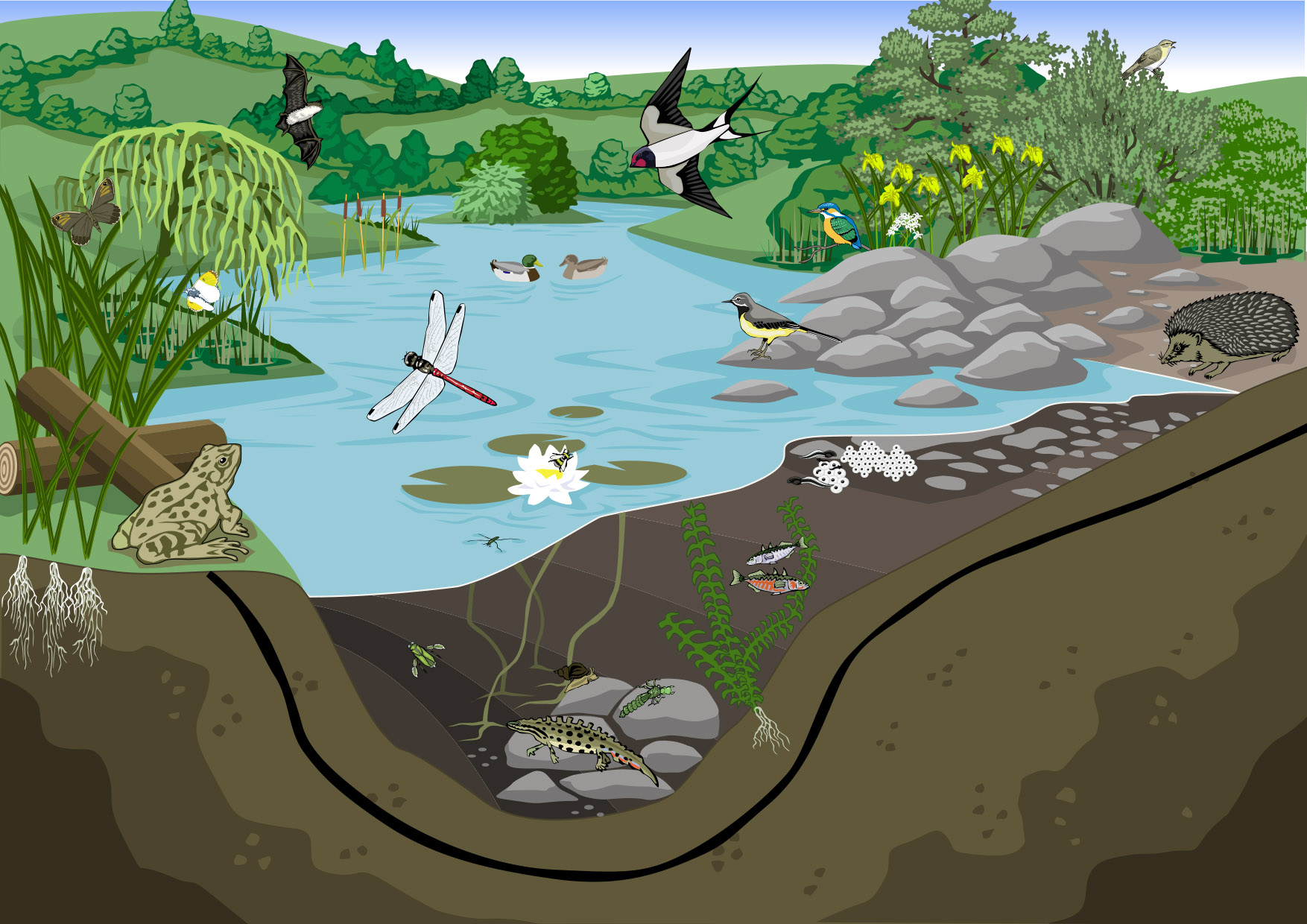Download how to build a pond pdf here
How and why to build a wildlife pond on your land
A pond is a simple and effective way of creating a diverse wildlife habitat on your farm. This step-by-step guide is designed to help you plan, locate, design, construct and manage your pond in a way that will maximise its benefit for wildlife and other ancillary uses.
Why build a pond on your farm?
Ecological benefits:
Many farmers report to us that putting a pond on their land is the single most effective way of attracting wildlife and improving biodiversity on an area of land. The diversity of species that live in and use ponds makes them an exciting and worthwhile addition to any farm.
Healthy ponds can support a vast array of aquatic plants, insects and other wildlife. For example, dragonflies, damselflies, bees, hoverflies, amphibians, bats, small mammals and birds often rely on ponds to drink, feed or breed.
Economic benefits:
- By slowing the flow of water across the land, ponds and wetlands can reduce soil erosion caused by heavy rainfall.
- Likewise, ponds can help to retain water on the land, releasing it slowly back into the soil in times of drought.
- Larger ponds can be used to store water for use around the farm.
- Depending on their design, ponds can be used to trap silt or sediment, or even to filter excess nutrients from farm run-off before it reaches watercourses. However, it’s important to remember that ponds that fulfil these ‘filtering’ functions have less value for wildlife than ‘clean water ponds’
- As the biodiversity value of ponds is increasingly recognised, there is likely to be an increase in the economic supports (grants) available to pond-building farmers and community groups – speak to your farm advisor, local NPWS ranger and Local Authority to see what supports are currently available.
There are numerous ways to design and dig a pond on your land – have some fun investigating the most suitable location and designing the optimum pond for your own farm and farming system. Here are some tips to get you started!
Where to start?
- Start by equipping yourself with some basic pond knowledge! Have a read through the tips here and dip into some of the links to further resources below.
- Have a walk around your land and identify suitable location(s) for a pond. An area that is already wet and boggy, has a natural spring, or could be fed by a drain or stream is an obvious place to start.
- If you don’t have a natural source of clean water for your pond, run-off can be diverted from a shed roof.
- Keep in mind current land management practices and any future plans you may have for the areas you identify.
- Put safety first – make sure your pond will not be a safety hazard for young children or livestock.
It can be useful to visit others who already have a pond on their land, as you can get first-hand ideas and advice. Where this is not an option, there are lots of online videos out there to help you to get your imagination going!
Designing your pond:
- Think about how the site will develop in the longer term – ideally, ponds are for life.
- Make sure that at least some of the pond edges are gently sloping. Much pond wildlife lives in the shallow water at the pond edge (1-10cms deep).
- Rather than digging a single, uniform pond – try and create a pond with multiple pools of varying size and depth – the greater the variety of habitats the greater the variety of species that will utilise your pond.
- Likewise, design your pond with many little bays and inlets to provide habitat diversity around the pond’s edge. You might even consider a mini-island if you are feeling very adventurous!
- Consider your soil type. Pond liners are not essential for creating ponds, however, they can be useful if the soil is highly permeable. It is important to cover the liner with a 6” layer of subsoil as this will help plants root in the pond. A geosynthetic clay liner (GCL) can be a cost-effective option that is easy to install.
- Consider the potential for multiple uses of the pond, as well as providing wildlife benefit. These will help to steer the design process; prioritising large volumes if you plan to use it for irrigation or drinking; potentially using shallow basins at the outlet for a watercress crop; drawdown potential for aquaculture harvesting.
Choosing a site:
- The location of your pond will ultimately depend on the soil type, the available water source(s) to fill the pond and the type of pond you plan to construct. If you are aiming for a clean water pond, it’s important that the pond is located in an area where it will not be fed by drains/streams/run-off containing high levels of pollutants. Clean water ponds should be located in catchments that are natural – areas like woodland, scrub, rough grassland or unimproved permanent pasture.
- Consider digging ponds near other existing wetlands to improve habitat connectivity (while at the same time avoiding damaging existing wetlands, springs or flushes).
- Remember that ponds don’t have to be full of water year-round – seasonal (ephemeral) ponds are also an important habitat.
- Choose a sunny spot with little shade (ideally approx. 10% shade).
- Gravity is an important factor. Your ideal location should be down-gradient of your water source and up-gradient of your potential other uses, if any.
Planning your dig!
- Before digging a pond, ensure that you are not causing any damage to existing habitats/species, especially with heavy machinery.
- When digging, take extreme care to avoid causing silt to enter watercourses: If incorporating a clean open farm drain, avoid removing the last remaining strip of ground between the new pond and the existing drain until the very last moment. If feeding water into or out of the pond via a small open channel, do the channel work last; starting with the outlet and then the inlet, so that the pond can fill without washing through silt into the watercourse.
- Keep inlets and outlets small – avoid having a constant flow of water through the pond.
- Often the best approach is to dig the pond, walk away and let it naturally develop – Sometimes the less we do the better! Once it has ‘settled’ (1-3 years), you can come back and modify or extend it, creating new pools and wetlands etc. or clearing excess vegetation.
- In terms of timing, there is no best time to dig a pond. Be mindful of compacting wet soil if digging in the winter and be mindful of breeding birds, frogs etc. if digging in the spring.
- It is a good idea to draw up a rough plan of the site in advance, highlighting the important features of the pond.
- Show your pond plan/drawing to your digger driver (if you are using one) before starting. Remember, not all digger drivers will understand the finer details of a wildlife pond (pools, slopes, etc.) so this might need to be clearly explained to them – and it’s probably best to supervise once the digging starts!
- So, final things to remember when talking with your digger driver are:
- size: dig bigger than the final aspired area of open water, because plants will inevitably encroach into the shallows over time;
- slope: have as shallow as possible, about 1:20 in parts if space is available;
- shape: undulating is better than regular and:
- depth: this will vary whether you use a liner or are relying on groundwater or surface runoff. Seasonally shallow or dry ponds are still good for wildlife.
Digging your pond:
- A wide range of machinery is available to dig ponds. If you are not experienced using large machinery, we recommend hiring a licenced driver for the job.
- Prior to construction, it is a good idea to mark out important areas such as the pond outlines, where heavy machinery can move about and where spoil should be placed.
- Stay with the digger driver throughout the process and ensure they are sticking to your plan.
- Start by stripping the topsoil from the entire dig area; including the pond area plus any perimeter embankments that will be used down-gradient of your pond. Spoil should always be sorted into ‘topsoil’ and ‘subsoil’ – it is important to avoid contaminating the water with nutrients from rich topsoil (remove topsoil and use elsewhere – it’s valuable stuff!)
- Then mould the subsoil as required to achieve your desired pond size and shape. If your field is on a gradient it may be possible to use excavated subsoil to build a lower retaining embankment, thus minimising soil movement. Otherwise excavated spoil can be spread around the pond/surrounding areas, or removed to elsewhere on the land. If there is going to be a large amount of excavated spoil following the digging process, make sure you have a plan in place for removing the spoil from the area and finding another use for it.
- Check your levels before the digger leaves the site to ensure that your water levels will be where you expect them when it rains.
Managing your pond:
- Resist the temptation to introduce plants or animals to your pond!! Leave it bare and plants and animals will colonise the space naturally very quickly (and it’s much more fun to wait and see what turns up..!)
- Do keep an eye out for invasive species. Even natives such as Bulrush, can colonise the pond after 2 or 3 years. These may need to be manually removed from the pond to avoid them taking over completely. It is easier to do that work as they appear than when they’ve got well established. Similarly, non native invasive species are easily spread from garden centres or from existing problem areas in the wild; a problem minimised by avoiding any new plant introductions other than natural colonisation.
- Appropriate fencing is important where livestock may otherwise enter the pond or where children are likely to be present.
Keep your pond clean and unpolluted – take every precaution to avoid slurry, fertilisers, sprays, silage effluent or sediment from entering your pond. (Silt trap measures can be downloaded from the Farm Buffer Zones page on www.wetlandsystems.ie).

| “A well-positioned pond can hold thousands of litres of useable water on your farm. This water can potentially be utilised for irrigation and to provide water for livestock. Many farmers who have created a farm pond glean great joy from it. A pond can be like a campfire; they are focal points, a place to gather around or stare into and contemplate. They can add greatly to the aesthetics and quality of life on a farm. That cursed wet corner that took so much work for so little gain while it was part of the farm production becomes a place of no work and peace. With the pace of farming today, measures that break the landscape’s productive monotony and create a place of mental respite should not be undervalued.”
Sligo beef farmer and Farming For Nature Ambassador, Clive Bright |
Make sure to avoid:
- digging ponds where there are existing valuable habitats (e.g. orchid rich grasslands, species rich wetlands).
- digging up peat soils – wet peat is a precious carbon-rich resource!
- digging ponds where you might damage uncommon species.
- using heavy machinery on the land during the wetter months.
- digging very deep and uniform ponds with steep slopes.
- disturbing existing habitats in the nesting season.
- allowing invasive plant species to colonise the area.
- introducing fish to a new pond – they eat frog eggs and insect larvae, limiting the pond’s diversity.
- inadvertently flooding your neighbours by changing water levels if blocking drains as part of your pond project.
Helpful resources online:
- The Million Ponds Project has a series of pond creation factsheets and species identification sheets. Find online.
- Find Pond design and construction with Feidhlim Harty on YouTube for tips from this wetlands ecologist.
- Find Do’s and dont’s of ponds with Feidhlim Harty on YouTube for tips from this wetlands ecologist.
- Look up Pond Power online and their tips on how to build a farm pond with useful visuals from their farm in Sweden.
- For ideas on cleaning up water entering your pond, the Farm Buffer Zones page on www.wetlandsystems.ie give tips and guidance.
More guides and resources on enhancing biodiversity on your farm Here
Thanks to the Department of Agriculture, Food and Marine, and the National Parks and Wildlife Service for jointly supporting this project.

